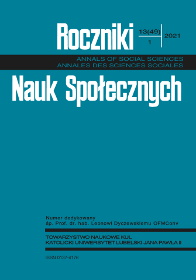Collective Memory and News Journalism
Abstract
The main goal of the article is to analyze the relationship between news journalism and collective memory. Based on the basic principles of news journalism, the specifics of the forms in which references to the past appear in media information materials are shown. Typification, premeditation and remediation were indicated as the most significant processes determining the ways of the presence of memory content in news. The main types of references to the past within news journalism were also discussed.
References
Barnhurst K.G. (2003), The makers of meaning: National Public Radio and the new long journalism,1980-2000, Political Communication, nr 20(1), s. 1-22.
Berkowitz D. (1992), Non-routine news and newswork: Exploring a what-a-story, Journal of Communication, nr 42(1), s. 82-94.
Dyczewski L. (2011), Kultura w całościowym planie rozwoju, Warszawa: Instytut Wydawniczy PAX.
Edy J.A., Daradanova M. (2006), Reporting through the lens of the past. From Challenger to Columbia, Journalism nr 7(2), s. 131-151.
Edy J.A. (1999), Journalistic uses of collective memory, Journal of Communication, nr 49(2), s. 71-85.
Erll A. (2018), Kultura pamięci. Wprowadzenie, posłowie i red. naukowa M. Saryusz-Wolska, Warszawa: Wydawnictwa Uniwersytetu Warszawskiego.
Galtung J., Ruge M.H. (1965), The structure of foreign news: The presentation of the Congo, Cuba and Cyprus crises in Four Norwegian Newspapers, Journal of Peace Research, nr 2(1), s. 64-90.
Grusin R.A. (2004), Premediation, Criticism, nr 46(1), s. 17-39.
Hoskins A., O’Loughlin B. (2010), War and media: The emergence of diffused war, Cambridge: Polity Press.
Huyssen A. (1995), Twilight memories: marking time in a culture of amnesia, New York: Routledge.
Kitch C. (2005), Pages from the past: History and memory in American magazines, Chapel Hill: University of North Carolina Press.
Kula M. (2002), Nośniki pamięci historycznej, Warszawa: Wydawnictwo DiG 2002.
Lang K., Lang G.E. (1989), Collective memory and the news, Communication, nr 11, s. 123-129.
Lule J. (2001), Daily news, eternal stories: The mythological role of journalism, New York: Guilford Press.
McDaniel M.A., Einstein, G.O. (2007), Prospective memory: An overview and synthesis of an emerging field, Thousand Oaks, CA, Sage.
Meyers O. (2002), Still photographs, dynamic memories: an analysis of the visual presentation of Israel’s history in commemorative newspaper supplements, Communication Review, 5(3), s. 179-205.
Mihelj S. (2009), Television news and the dynamics of national remembering, [w:] E. Castello, A. Dhoest, H. O’Donnell (red.), The nation on screen: Discourses of the national on global television, Cambridge: Cambridge Scholars Publishing, s. 119-138.
Schudson M. (1992), Watergate in American memory: How we remember, forget and reconstruct the past, New York: BasicBooks.
Schütz A. (1984), Potoczna i naukowa interpretacja ludzkiego działania, [w:] E. Mokrzycki (red.), Kryzys i schizma. Antyscjentystyczne tendencje w socjologii współczesnej, Warszawa: Państwowy Instytut Wydawniczy, t. 1, s. 137-192.
Szwed R. (2009), Proces produkcji informacji: od gatekeepera do public relations, [w:] L. Dyczewski (red.), Jaka informacja?, Lublin–Warszawa: Wydawnictwo KUL, Centrum Europejskie Natolin, s. 53-73.
Taibbi M. (2021), Pandemia przyspieszyła polaryzację. Wywiad przeprowadził K. Cieślik, Rzeczpospolita: Plus-Minus, 20-21.02.2021.
Teer-Tomaselli R. (2006), Collective memory and media news, Global Times. The Communication for Development Journal, nr 5.
Tuchman G. (1972), Objectivity as strategic ritual: An examination of newsmen’s notion of objectivity, American Journal of Sociology, nr 77(4), s. 660-679.
Zandberg E., Meyers O., Neiger M. (2012), Past continuous newsworthiness and the shaping of collective memory, Critical Studies in Media Communication, nr 29(1), s. 65-79.
Zandberg E. (2010), The right to tell the (right) story: Journalism, authority and memory, Media, Culture & Society, nr 32(1), s. 5-24.
Zelizer B. (1992), „Covering the body”: The Kennedy assassination, the media and the shaping of collective memory, Chicago: University of Chicago Press.
Zelizer B. (2008), Journalism’s memory work, [w:] A. Erll, A. Nünning (red.), Cultural memory studies: An international and interdisciplinary handbook, Berlin–New York: Walter de Gruyter, s. 379-387.
Zelizer B. (1993), News: First or final draft of history?, Mosaic, 2(1), s. 2-3.
Zelizer B. (2004), When war is reduced to a photograph, [w:] S. Allan, B. Zelizer (red.), Reporting war: Journalism in wartime, London: Routledge, s. 115-135.
Copyright (c) 2021 Roczniki Nauk Społecznych

This work is licensed under a Creative Commons Attribution-NonCommercial-NoDerivatives 4.0 International License.


